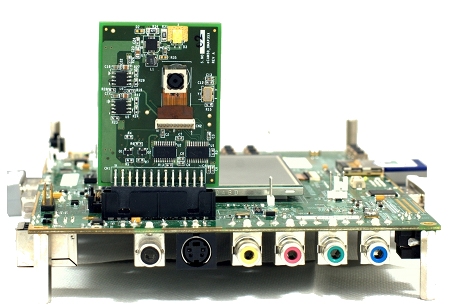Cortex-A8 evaluation module gets five megapixel camera
Apr 19, 2011 — by LinuxDevices Staff — from the LinuxDevices Archive — 5 viewsE-con Systems has announced a five megapixel camera add-on designed to work with the Texas Instruments (TI) DM3730 evaluation module (EVM). The e-CAM50_DM37x snaps onto the EVM board and connects to the high-speed CMOS sensor interface on TI's DM37xx or Sitara AM37xx processors, providing 720p video capture as well as stills, the company says.
E-con has produced e-CAM modules for a variety of platforms. To cite one example, it launched a 3.2 megapixel camera module known as the e-CAM32_OMAP35x for TI's OMAP35x EVM in 2009, and upgraded this to the 5.0 megapixel e-CAM50_OMAP35x version in 2010.

The e-CAM50_OMAP37x mounted on TI's DM3730 EVM
The company's latest camera module is the e-CAM50_DM37x, which, as pictured above, connects directly to TI's DM3730 EVM board. (For more on the EVM and the processors it supports, see later in this story.) The new module uses the same Omnivision OV5642 CMOS image sensor as the e-CAM50_OMAP35x, allowing not only the capture of five megapixel stills, but also 720p video at up to 30 frames per second, according to E-con.
E-Con says the e-CAM50_DM37x can also capture VGA-resolution video at up to 55 frames per second, and 120 per second for QVGA. The LED flash-equipped module is supplied with a Windows CE driver, and support for Windows Embedded Compact 7, Linux, and Android, is planned, the company adds.
Background
 The DM3730 EVM (right) — or TMDXEVM3730, to use its full name — was designed by Mistral Solutions and is marketed by TI, supporting four different ARM Cortex A8-based processors. These are the Sitara AM3517 and AM3703, announced in June 2010, plus the DM3730 and DM3725, leaked at the same time but not formally announced (for reasons known only to TI) until last August.
The DM3730 EVM (right) — or TMDXEVM3730, to use its full name — was designed by Mistral Solutions and is marketed by TI, supporting four different ARM Cortex A8-based processors. These are the Sitara AM3517 and AM3703, announced in June 2010, plus the DM3730 and DM3725, leaked at the same time but not formally announced (for reasons known only to TI) until last August.
The AM37x and DM37x are pin- and software-compatible with one another. Compared to TI's earlier DM35x and AM35x processors, also Cortex A8-based, they offer increased CPU and graphics performance while using at least 40 percent less power, the chipmaker says.
Available in 1GHz, 800MHz, and 600MHz versions, the AM37x processors lack video acceleration DSPs, but the AM3715 includes a OpenGL ES 2.0 2D/3D graphics accelerator. The DM3725, meanwhile, gets a C64+ DSP, while the DM3730 includes both this and the Imagine Technologies PowerVR SGX-based OpenGL accelerator.
TI claims the DSP engine in the DM37xx SoCs is more programmable than ever. It includes a royalty-free library of DSP-optimized signal processing algorithms accessible from the ARM processor via a set of "easy-to-use" application programming interfaces (APIs), according to the company.
The DSP library is said to contain more than 80 algorithms, including multimedia decoders and encoders, math functions, digital filtering including Fast Fourier Transform (FFT), and image processing including image filtering and analysis. Examples include an edge-detection algorithm for a camera-enabled industrial application that can detect the presence or absence of people or objects, TI says.
In addition to the AM37x or DM37x processors, the DM3730 EVM provides 256MB of RAM, 512MB of flash storage, and a 3.7-inch touchscreen display available in 640 x 480 or 320 x 240 resolutions. The board also includes an SD/MMC slot and real-world ports for Ethernet, serial, USB host and On-the-Go, plus audio and video output, TI adds.
Ashok Babu, president of E-Con Systems, stated, "The Sitara/DaVinci offers 50 percent more ARM power and 40 percent more DSP power. It is also highly power efficient compared to its predecessors. This product will definitely speed up the time to market for those customers who are interested in integrating cameras with the AM3715 or the DM3730."
Further information
E-con Systems says the e-CAM50_DM37x is available now for approximately $350 exclusive of shipping. More information may be found on the company's website, here.
This article was originally published on LinuxDevices.com and has been donated to the open source community by QuinStreet Inc. Please visit LinuxToday.com for up-to-date news and articles about Linux and open source.